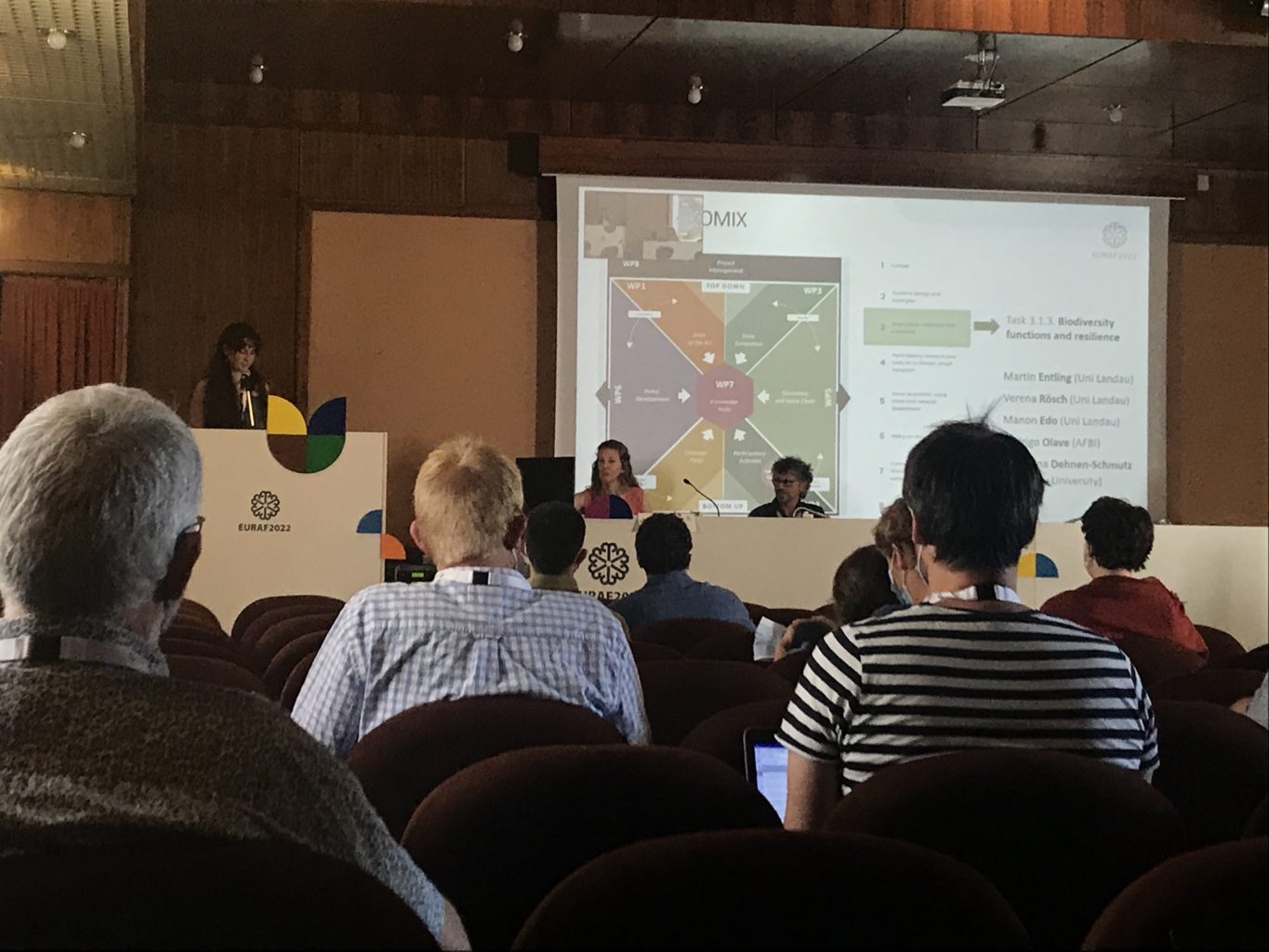“As advocates of agroforestry, we know that the future is on our side. Our job is to make sure that this future comes soon, and the prize may the enhancement of millions of human lives.” This was the leading message of Patrick Worms – President of the European Agroforestry Federation (EURAF) – at EURAF’s 6th European Agroforestry Conference, held from 16-20th May 2022 in Nuoro (Sardinia, Italy), at the Federation’s first in-person conference since the outbreak of COVID-19.
The objective of the conference was to build on the increasing volume of scientific evidence of the benefits of agroforestry – including increased biodiversity, soil fertility, carbon sequestration, diversification of farmers’ income, and the preservation of cultural heritage – and use new case studies and evidence to explore the latest innovations in implementing agroforestry systems that could lead to the upscaling of this practice in Europe, and beyond. The event brought together 250 people on site, plus 60 online attendees. Amongst these were researchers, practitioners, policymakers, and agroforestry enthusiasts, exchanging their experiences to feed into each other’s ongoing and future efforts. The event also offered a series of field visits, for participants to see some of the most iconic agroforestry systems in Europe, including the Cork/Holm oak silvopastoral lands that – according to EURAF – are the most common systems in the Mediterranean region, offering multiple ecosystem services.
The presentations ranged from recent innovations in vitiforestry – the use of agroforestry systems in vineyards, that has been taking place in Europe since 1498 – to high-tech ‘digital agriculture’ systems (elaborated below), that may transform farming as we know it today, by using smart robots to carry out simple tasks, that may support our efforts to achieve low-impact agricultural systems.

AGROMIX held two sessions at the Conference, as well as moderating and participating in other panel discussions. These gave ample opportunity for researchers to share their experiences and results from the first 18 months of the project. The first AGROMIX representative to take the floor was Rosemary Venn – Researcher at AGROMIX’s coordinating Centre for Agroecology, Water and Resilience (Coventry University, UK). She introduced the project by presenting AGROMIX’s driving questions and objectives: What are farmers’ interests in climate-smart agriculture? What are the obstacles to its implementation? And, how can we give farmers a voice? Before delving into these topics in depth, Venn shared that in a recent survey with farmers, 77% of respondents said they were interested in implementing systems that offer additional ecosystem services, but that they cited knowledge, money, and time as key obstacles.
Sara Bergante – from the Italian Research Center for Forests and Wood – shared success stories from AGROMIX research, where her team had studied innovation in the elements typically used in agroforestry systems. Whilst Poplar trees have often dominated agroforestry systems – used for timber production – Bergante shared cases of farmers planting other productive species, such as walnut, and even successfully integrating saffron production into agroforestry systems. According to her team, communicating these cases can open people’s minds towards the potential combinations of agroforestry elements, and the benefits these would offer to farmers.
On Thursday 19th – during a technical session hosted by AGROMIX – Felix Herzog, from the Swiss research centre Agroscope – shared results from their research on public perceptions of agroforestry. Herzog’s team carried out a survey where participants were shown a variety of landscapes, with different levels of biodiversity, and chose which one they would prefer to be expanded in their surroundings; the results showed a clear preference for landscapes that integrated trees and animals. Herzog also highlighted the importance of creating public diversified landscapes – beyond the scope of food production – to support human health and well-being, offering biodiverse public spaces recreational activities. Herzog ended his intervention with a note on incentives and motivation for integrating trees into existing monoculture landscapes. He found that whilst the farmers in Switzerland have not been especially interested in enhancing biodiversity per se, if researchers are able to prove the potential economic rewards of diversifying their farms, that’s when change would take place. One example Herzog cited was that of ladybirds. Whilst the farmers he worked with had typically given little importance to these insects, when his research team was able to demonstrate that they removed pests that damaged the farmers’ crops, farmers were open to exploring protection strategies such as shelter in winter, and increasing pollinating plants in spring.

On behalf of the German University of Koblenz-Landau, Manon Edo presented some of the research carried out for AGROMIX. Her team focuses on bird diversity in agroforestry systems. Edo explained that to assess whether agroforestry systems and biodiversity affected bird populations and behaviour, they selected 77 sample sites: agroforestry fields (silvoarable and silvopastoral) as well as control fields (open pastures, crop fields without trees and forest sites). Audio recorders were used to sample bird sounds three times during spring at sunrise . They then identified the bird species present in each field type and confirmed their hypothesis that fields with trees – i.e. forests and agroforestry fields – had a higher bird species diversity than the open sample sites. Their research also showed that each field type harboured different bird communities which highlights the importance of landscape diversity. Especially in intensively used agricultural landscapes, agroforestry fields could thus provide habitats with a high conservation potential for bird species that require semi-open habitats.

On the final day of the conference, Marie Gosme from INRAE – another AGROMIX partner – and while presenting the recently EU project funded: DIGITAF opened a debate about the pros, cons, and future of ‘digital agriculture’. Gosme introduced digital agriculture as having four elements: 1. Collecting data using sensors, smartphones, satellites, and even social media; 2. Connecting this data through the Internet of Things, satellite networks, and data exchange, 3. Computing this data using algorithms, software, models, decision support systems, artificial intelligence, and visualisation, and lastly, 4. Creating robots and that can carry out certain tedious or challenging tasks in agricultural production. This presentation led to interactive debate, with Gosme inviting attendees to participate in a live poll, asking them whether they see digital agriculture as a threat or an opportunity for upscaling agroforestry. Two thirds of the respondents believed it to offer opportunities, whilst one third were concerned about the damage that advanced technology could bring to such a farmer-centred approach as agroforestry. Gosme agreed that while further research could identify ways to optimise these systems for productive agroforestry, there are plenty of concerns, including a loss of autonomy for farmers, dubious data ownership – with the data systems providers charging farmers for high-tech machinery, whilst storing their data – the standardisation of agricultural landscapes, and lastly, a weakening of the human-nature relationship, which is already being affected by urbanisation and mechanisation of agriculture.

Lastly, on Tuesday 17th, AGROMIX held a unique free and hybrid Q&A session called #AskAScientist. This panel discussion was the result of a two-month social media campaign where the AGROMIX communications team used a variety of strategies to gather questions from their online following, to address people’s lingering questions such as how we can implement agroforestry at scale, to what extent it is currently taking place, etc. For one hour, the panellists answered questions ranging from ‘What is regenerative farming?’, to technical questions such what factors determine fast tree establishment and mykorrhiza symbiosis. Four panellists answered a selection of the questions gathered, and opened a debate on the differences and interrelations between permaculture, agroecology, regenerative farming, and agroforestry.
Patrick Worms – one of the panellists – shared that agroforestry can be considered an element of the broader umbrella of permaculture design, and that rather than a technique, regenerative farming can be considered a philosophy of “everything starts from the soil”, whereby soil replenishment and long-term planning for food security and fertile landscapes are the objective. Panellists discussed the lack of evidence of whether agroforestry can be carried out at scale, or whether in fact we must opt for numerous smaller-scale agroforestry farms to supply our food needs. The question of whether agroforestry production can be used to feed a growing population led to some disagreement, and will therefore be explored in AGROMIX’s upcoming Agroforestry FAQ Handbook, based on the questions gathered through this campaign. The recorded Q&A session is now available on the project’s YouTube channel.
Supporting policy was also a key discussion point during the Conference, with speakers such as Andrea Schievano from the European Commission’s Joint Research Centre (EUJCR) EU recognising that the EU’s Common Agricultural Policy has received criticism even internally for its lack of ambition for supporting agroforestry systems, as a way to contribute to the EU’s wider goals in relation to climate change and environmental conservation.
A second challenge debated in the session on policy for agroforestry was about the short- and long-term thinking when it comes to designing and implementing agroforestry systems. One attendee intervened in the discussion, highlighting that we must make a clear difference between planting and growing/caring for trees. The debate concluded that some farmers may plant seedlings or young trees to comply with certain regulations and apply for subsidies, but planting trees is in fact only the first step. Therefore, support systems must be put in place to monitor tree growth, and not leave farmers alone in this process.

On the final day of the event, Jacopo Goracci presented his farm – Tenuta di Paganico – which is also one of the long-term agroforestry sites that supports AGROMIX’s research. Tenuta di Paganico has been running since 1924, and Goracci shared his key learnings over the years. One of these was to begin the design of an agroforestry system by conducting a thorough analysis of the most appropriate animal breeds for each region. Furthermore, he stressed the importance of providing extensive and biodiverse systems for animal welfare, allowing herds the opportunity to eat, breed and raise their young where is most suited to their instincts. Lastly, he shared some practical advice with the practitioners and advisors present, encouraging more farmers to plant alfalfa, which in his experience simultaneously offered valuable feed for his livestock, and contributed to his land’s soil fertility.
“Between the war in Ukraine and the increasing impact of climate change on crop yield, there could be as many as 1.6 million more people without enough food to eat in the coming year”. Patrick Worms began his closure of the conference with a recognition of the key challenges we face in terms of food security and land degradation. However, he went on to say that as evidence is mounting to support the transition towards agroforestry systems, our main challenge is to simplify our communications, and find the numbers and methods to guide farmers towards implementing these practices. While numerous panellists said there’s still a lack of clear evidence to prove agroforestry’s profitability to farmers, Rosmary Venn shared her optimism that the increasing volume of popular literature on the topic is increasing the public’s awareness of the alternatives to industrial agriculture, and political action is gradually following suite. Thanking all the dedicated advocates for agroforestry present, Patrick Worms’ final words were “As you all go back to your normal work, remember that the salary that pays you is not what makes you feel good; it’s the knowledge that you’re making a difference to real human lives.”
